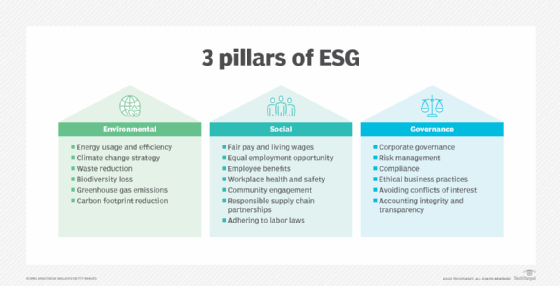
Getty Images
Compare ESG tools from AWS, Azure and Google Cloud
ESG standards are beginning to influence how large enterprises procure and consume cloud services. Take a closer look at the offerings from the biggest providers.
As pressing global challenges continue to rise, some companies are seeking a way to reduce their impact on the environment, while committing to the ethical treatment of their communities. As the cloud plays a dominant role in company infrastructure, cloud service providers are releasing tools to monitor the impact of the cloud on the world.
In this article, we learn how the environment and related factors intersect with cloud computing. Additionally, we explore environmental, social and governance (ESG) tools from the major cloud providers, including Amazon, Microsoft and Google, as well as third-party options.
ESG and the cloud
ESG is a framework that assesses an organization's impact and sustainability across these three aspects:
- Environmental. The environmental aspect focuses on a company's environmental stewardship. This includes managing its environmental impact by reducing greenhouse gas emissions, managing natural resources sustainably and preparing for physical climate risks, like flooding and fires.
- Social. The social aspect examines a company's relationships with its customers, employees, suppliers and the communities in which it operates. This includes human capital management, fair wages, employee engagement and the enterprise's broader impact on society.
- Governance. The governance portion focuses on a company's internal practices and policies that guide its actions, leadership, incentives and overall management. Key considerations include leadership incentives aligning with sustainable practices, shareholder rights, and the transparency and accountability of company leadership.
ESG is at an inflection point in the investment world. It rose to play a significant role in investment decision-making because it used nonfinancial factors to augment traditional financial analysis to better analyze the opportunities and risks in an organization.

Cloud service providers (CSPs) are also feeling market and investor pressure to improve their ESG performance, especially considering the impact of data center growth on the environment. ESG efforts push cloud computing to be more efficient than traditional IT infrastructure, thereby enhancing CSP environmental scores. Potential customers -- who want out of the IT infrastructure business while still being good corporate citizens by increasing their energy efficiency and reducing waste -- are more likely to choose a cloud provider with an ESG framework.
Cloud services can also accelerate decarbonization initiatives, which reduces implementation costs and supports compliance with climate regulations. AI, machine learning and IoT, which are all in-demand cloud services, can contribute to decarbonization efforts.
Choose the right ESG tool
For enterprises considering migration to a new CSP based on ESG compliance, intentionality is everything. Note what features are important to your organization, such as comprehensive ESG coverage, the provider's sustainability management software or transparent ESG reporting capabilities. These are the latest ESG tools from the top three CSPs.
AWS
AWS Customer Carbon Footprint Tool (CCFT) helps AWS customers track, measure, review and forecast the carbon emissions associated with their AWS usage. It follows Greenhouse Gas Protocol standards and provides a dashboard with data visualizations that offer insights into emissions by service and geographical location. Per Amazon's Climate Pledge, this tool is part of its commitment to power operations with 100% renewable energy by 2025 and achieve net-zero carbon emissions by 2040.
CCFT supports CSV downloads for detailed analysis and integration into other reporting systems. With its improved granularity for carbon data, users can examine emissions by service and region. AWS has also reduced the reporting threshold to three decimal places, which enables customers with smaller footprints to view their data. This enhanced visibility helps organizations manage and optimize their sustainability initiatives more effectively.
Microsoft Azure
The Microsoft Cloud for Sustainability suite helps companies measure carbon emissions, manage sustainability goals and streamline reporting processes. It features tools like Sustainability Manager for automated data collection and emissions calculations, as well as Emissions Impact Dashboard for analyzing Azure and Microsoft 365 usage emissions. The suite provides actionable insights for companies' sustainability efforts and ensures compliance with reporting standards.
Google Cloud
Google Cloud follows a unique strategy to integrate ESG into its cloud services. Google Cloud provides carbon-free energy scores for its cloud regions, which enable its customers to consider lower carbon emissions in the earliest design phase of their cloud initiatives.
To make data more accessible and actionable to businesses and investors, Google Cloud partners with ESG Book for advanced data tools. ESG Book provides transparent and comparable ESG data to all stakeholders and aligns with the United Nations Global Compact principles.
Third-party ESG vendors
If you prefer to use a more specialized tool that can bridge multiple environments, these three vendors -- listed alphabetically and chosen based on industry research -- offer multi-cloud-friendly ESG tools:
- Benchmark Digital Partners offers a broad range of sustainability and ESG management capabilities.
- Diligent provides governance, risk and compliance software with added sustainability and ESG reporting tools.
- Ecometrica specializes in measuring greenhouse gas emissions and monitoring deforestation risks.
Will Kelly is a freelance writer and content strategist who has written about cloud, DevOps, AI and enterprise mobility.







